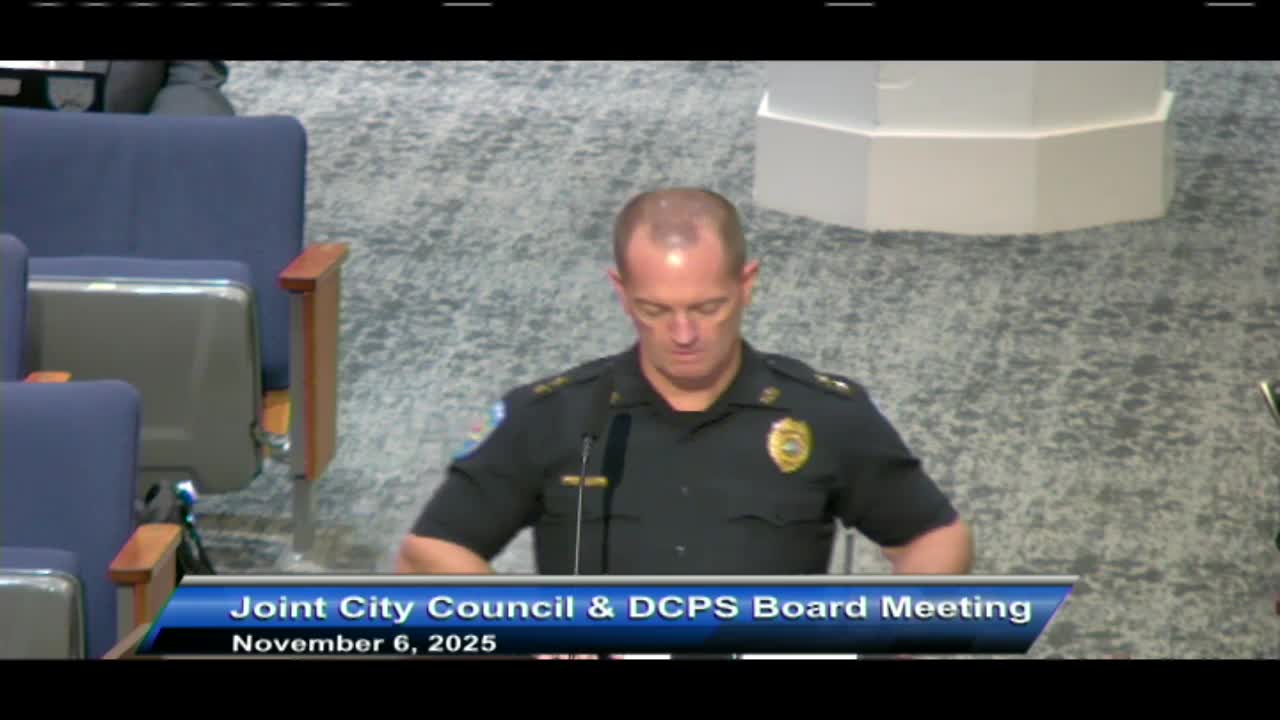Duval launches "Be Safe, Be Seen" campaign, expands traffic‑safety education and traffic gardens
November 06, 2025 | Jacksonville, Duval County, Florida
This article was created by AI summarizing key points discussed. AI makes mistakes, so for full details and context, please refer to the video of the full meeting. Please report any errors so we can fix them. Report an error »

Duval County Public Schools unveiled a districtwide pedestrian-safety effort called "Be Safe, Be Seen" that combines classroom education, campus visibility and community engagement to reduce student injuries while walking and bicycling to school.
Chief Jackson Short, the district's school police chief, said the district began tracking pedestrian strikes last year and found 43 students struck as pedestrians in the school year, with three fatalities. "This academic school year we are just starting our second nine weeks. We are already at 10 students struck, two of those being fatal," Short said, urging broader city partnerships because many incidents occur outside formal school zones.
Dr. Heather Albritton, the district's director of health and physical education, described the campaign's three pillars: integrating safety lessons into health and physical education and student leadership projects; increasing visible reminders and signage across campuses; and engaging partners such as Jacksonville Sheriff's Office, Jacksonville Fire & Rescue Department, the North Florida Transportation Planning Organization and local businesses. She highlighted the district's traffic-garden program, a low‑risk, scaled street environment painted at some campuses that lets students practice crossing and bike/pedestrian skills.
The district has a paper "Be Safe, Be Seen" pledge and plans a digital reengagement in January that will include a QR code for community pledges. Albritton told the joint meeting the district wants the campaign to reach adults as well as students, providing resource materials for parents and community leaders.
Why it matters: District leaders framed the effort as a response to recent student injuries and fatalities and as part of an equity effort to give students in neighborhoods without sidewalks a place to practice safe travel habits. Albritton said traffic gardens will be aligned with the Safe Routes to School program and Vision Zero principles and that the district's first traffic garden on a public park (outside school property) is being initiated this month so community members can use it outside school hours.
What was not decided: The meeting included no new funding commitments from the city; council members and board members raised questions about how many school zones lack crossing lights or sidewalks and asked for cost estimates and prioritization. The district asked council members to collect signatures on the pledge and to share materials in their communities.
Ending: The district said the campaign will continue year‑round, with a formal reengagement scheduled for January and continued coordination with city agencies on enforcement and capital improvements.
Chief Jackson Short, the district's school police chief, said the district began tracking pedestrian strikes last year and found 43 students struck as pedestrians in the school year, with three fatalities. "This academic school year we are just starting our second nine weeks. We are already at 10 students struck, two of those being fatal," Short said, urging broader city partnerships because many incidents occur outside formal school zones.
Dr. Heather Albritton, the district's director of health and physical education, described the campaign's three pillars: integrating safety lessons into health and physical education and student leadership projects; increasing visible reminders and signage across campuses; and engaging partners such as Jacksonville Sheriff's Office, Jacksonville Fire & Rescue Department, the North Florida Transportation Planning Organization and local businesses. She highlighted the district's traffic-garden program, a low‑risk, scaled street environment painted at some campuses that lets students practice crossing and bike/pedestrian skills.
The district has a paper "Be Safe, Be Seen" pledge and plans a digital reengagement in January that will include a QR code for community pledges. Albritton told the joint meeting the district wants the campaign to reach adults as well as students, providing resource materials for parents and community leaders.
Why it matters: District leaders framed the effort as a response to recent student injuries and fatalities and as part of an equity effort to give students in neighborhoods without sidewalks a place to practice safe travel habits. Albritton said traffic gardens will be aligned with the Safe Routes to School program and Vision Zero principles and that the district's first traffic garden on a public park (outside school property) is being initiated this month so community members can use it outside school hours.
What was not decided: The meeting included no new funding commitments from the city; council members and board members raised questions about how many school zones lack crossing lights or sidewalks and asked for cost estimates and prioritization. The district asked council members to collect signatures on the pledge and to share materials in their communities.
Ending: The district said the campaign will continue year‑round, with a formal reengagement scheduled for January and continued coordination with city agencies on enforcement and capital improvements.
View full meeting
This article is based on a recent meeting—watch the full video and explore the complete transcript for deeper insights into the discussion.
View full meeting